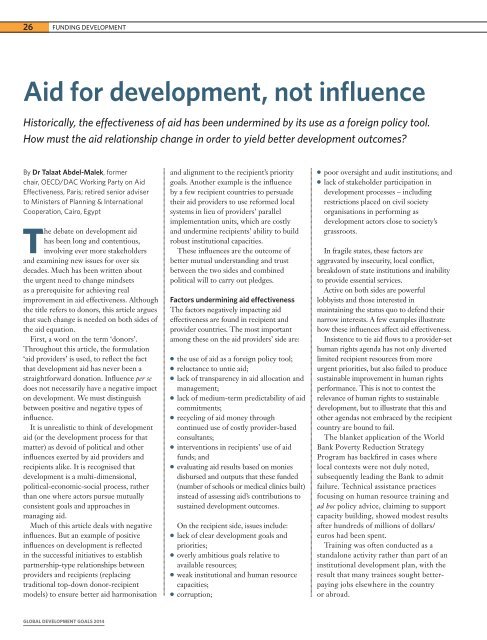FAMBB
FAMBB
FAMBB
You also want an ePaper? Increase the reach of your titles
YUMPU automatically turns print PDFs into web optimized ePapers that Google loves.
26 FUNDING DEVELOPMENTAid for development, not influenceHistorically, the effectiveness of aid has been undermined by its use as a foreign policy tool.How must the aid relationship change in order to yield better development outcomes?By Dr Talaat Abdel-Malek, formerchair, OECD/DAC Working Party on AidEffectiveness, Paris; retired senior adviserto Ministers of Planning & InternationalCooperation, Cairo, EgyptThe debate on development aidhas been long and contentious,involving ever more stakeholdersand examining new issues for over sixdecades. Much has been written aboutthe urgent need to change mindsetsas a prerequisite for achieving realimprovement in aid effectiveness. Althoughthe title refers to donors, this article arguesthat such change is needed on both sides ofthe aid equation.First, a word on the term ‘donors’.Throughout this article, the formulation‘aid providers’ is used, to reflect the factthat development aid has never been astraightforward donation. Influence per sedoes not necessarily have a negative impacton development. We must distinguishbetween positive and negative types ofinfluence.It is unrealistic to think of developmentaid (or the development process for thatmatter) as devoid of political and otherinfluences exerted by aid providers andrecipients alike. It is recognised thatdevelopment is a multi-dimensional,political-economic-social process, ratherthan one where actors pursue mutuallyconsistent goals and approaches inmanaging aid.Much of this article deals with negativeinfluences. But an example of positiveinfluences on development is reflectedin the successful initiatives to establishpartnership-type relationships betweenproviders and recipients (replacingtraditional top-down donor-recipientmodels) to ensure better aid harmonisationand alignment to the recipient’s prioritygoals. Another example is the influenceby a few recipient countries to persuadetheir aid providers to use reformed localsystems in lieu of providers’ parallelimplementation units, which are costlyand undermine recipients’ ability to buildrobust institutional capacities.These influences are the outcome ofbetter mutual understanding and trustbetween the two sides and combinedpolitical will to carry out pledges.Factors undermining aid effectivenessThe factors negatively impacting aideffectiveness are found in recipient andprovider countries. The most importantamong these on the aid providers’ side are:●●the use of aid as a foreign policy tool;●●reluctance to untie aid;●●lack of transparency in aid allocation andmanagement;●●lack of medium-term predictability of aidcommitments;●●recycling of aid money throughcontinued use of costly provider-basedconsultants;●●interventions in recipients’ use of aidfunds; and●●evaluating aid results based on moniesdisbursed and outputs that these funded(number of schools or medical clinics built)instead of assessing aid’s contributions tosustained development outcomes.On the recipient side, issues include:●●lack of clear development goals andpriorities;●●overly ambitious goals relative toavailable resources;●●weak institutional and human resourcecapacities;●●corruption;●●poor oversight and audit institutions; and●●lack of stakeholder participation indevelopment processes – includingrestrictions placed on civil societyorganisations in performing asdevelopment actors close to society’sgrassroots.In fragile states, these factors areaggravated by insecurity, local conflict,breakdown of state institutions and inabilityto provide essential services.Active on both sides are powerfullobbyists and those interested inmaintaining the status quo to defend theirnarrow interests. A few examples illustratehow these influences affect aid effectiveness.Insistence to tie aid flows to a provider-sethuman rights agenda has not only divertedlimited recipient resources from moreurgent priorities, but also failed to producesustainable improvement in human rightsperformance. This is not to contest therelevance of human rights to sustainabledevelopment, but to illustrate that this andother agendas not embraced by the recipientcountry are bound to fail.The blanket application of the WorldBank Poverty Reduction StrategyProgram has backfired in cases wherelocal contexts were not duly noted,subsequently leading the Bank to admitfailure. Technical assistance practicesfocusing on human resource training andad hoc policy advice, claiming to supportcapacity building, showed modest resultsafter hundreds of millions of dollars/euros had been spent.Training was often conducted as astandalone activity rather than part of aninstitutional development plan, with theresult that many trainees sought betterpayingjobs elsewhere in the countryor abroad.GLOBAL DEVELOPMENT GOALS 2014


